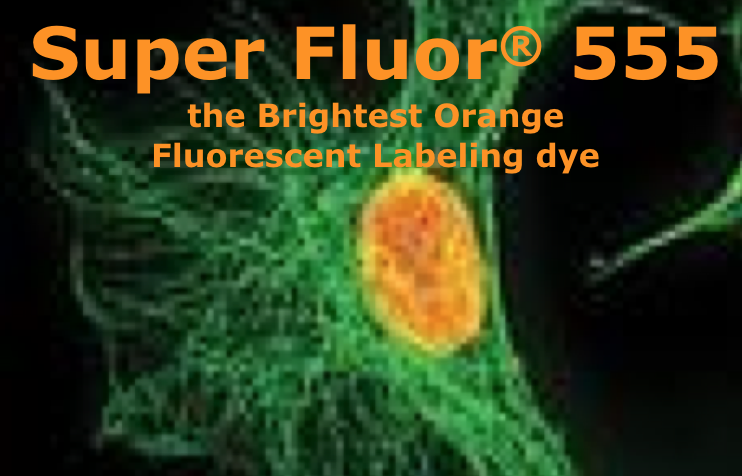Super Fluor® 488,555, 647, 680, 750 NHS ester
SE =NHS = succinimidyl ester
Super Fluor® is registered trademarks and strictly forbidden to be used without authorization.
1.Introduction
Super Fluor® dyes are the ideal substitute for Alexa Fluor dyes. Superfluor® dyes are a series of superior fluorescent labeling dyes that span the full visible spectrum. These dyes have better labeling performances than the classic fluorescent labeling dyes such as Cy 3, Cy5, FITC and Texas Red. Superfluor dyes and their conjugates have the following advantages:
· Absorption maxima compatible with all the common light sources of fluorescent instruments.
· Superfluor conjugates exhibit more intense fluorescence than other spectrally similar conjugates of classic fluorescent dyes such as FITC, TAMRA and ROX under similar excitations.
· Superfluor dyes are more photostable than the classic fluorescent dyes such as FITC, Cy3 and Cy5.
· Superfluor dyes have good water solubility for ease of conjugation and the resultant conjugates are resistant to precipitation and aggregation
· Superfluor dyes and their conjugates are available in several distinct fluorescent colors.
· Superfluor dyes are highly fluorescent over a broad pH range with little pH sensitivity.
· Superfluor dyes are available in a variety of reactive forms.
Superfluor® 555 Dyes, Superior Upgrades for Cy3 Dye Derivatives
| Molecular weight | Excitation (nm) | Emission (nm) | Extinction coefficient (cm-1 M-1) | Quantum yield |
| ~1250 | 555 | 568 | 15500 | 0.1 |
Super Flour® 555 SE is is a bright red fluorescent dye with the same chemical structure of Alexa Fluor 555. It is water soluble and pH-insensitive from pH 4 to pH 10. The NHS ester (or succinimidyl ester) of Superfluor®555 is the most convenient amine-reactive form for conjugating this dye to a protein or antibody.
Cy3 is the preferred dye for preparing orange fluorescent bioconjugates. Compared to the spectra of Cy3 dyes, the spectra of Superfluor 555 conjugates are slightly red-shifted, resulting in an optimal match to filters designed for Cy3 dyes. Superfluor 555 is more photostable than Cy3, providing researchers with additional time for image capture. Additionally, our in-house data indicated that Superfluor 555 is superior to Cy3 in fluorescence polarization-based assays.
Superfluor® 555 Labeling Dyes
Cat# | Name | Size | Price | Ex (nm) | Em (nm) | Soluble in |
1152 | Superfluor™ 555 acid | 5 mg | $95 | 556 nm | 567 nm | Water |
1153 | Superfluor™ 555 acid, SE* | 1 mg | $95 | 556 nm | 567 nm | Water |
1450 | Superfluor™ 555 C5 maleimide | 1 mg | $195 | 555 nm | 567 nm | Water |
1551 | Superfluor™ 555 hydrazide | 1 mg | $195 | 556 nm | 567 nm | Water |
*SE =NHS = succinimidyl ester.
NHS ester labeling of amino biomolecules
Super Fluor 488,555, 647, 680, 750
488 | 555 | 647 | 680 | 750 | |
molecular weight | ~900 | ~1250 | ~1300 | ~1150 | ~1300 |
λmax(nm) Ex | 494 | 555 | 647 | 680 | 750 |
Molar Absorption Coefficient(M-1cm-1) | 71 000 | 150 000 | 239 000 | 184000 | 240 000 |
λmax(nm) Em | 524 | 565 | 665 | 702 | 775 |
A280nm /Amax | 11% | 8% | 3% | 5% | 4% |
Succinimidyl esters are proven to be the best reagents for amine modifications because the amide bonds that are formed are essentially identical to, and as stable as the natural peptide bonds. These reagents are generally stable and show good reactivity and selectivity with aliphatic amines. There are few factors that need be considered when SE compounds are used for conjugation reaction:
1). Solvents: Dissolve NHS ester in 1/10 reaction anhydrous volume of DMF or DMSO.
2). Reaction pH: The labeling reactions of amines with succinimidyl esters are strongly pH dependent. Amine-reactive reagents react with non-protonated aliphatic amine groups, including the terminal amines of proteins and the e-amino groups of lysines. Thus amine acylation reactions are usually carried out above pH 7.5. Protein modifications by succinimidyl esters can typically be done at pH 7.5-8.5, whereas isothiocyanates may require a pH 9.0-10.0 for optimal conjugations.
3). Reaction Buffers: Buffers that contain free amines such as Tris and glycine and thiol compounds must be avoided when using an amine-reactive reagent. Ammonium salts (such as ammonium sulfate and ammonium acetate) that are widely used for protein precipitation must also be removed (such as viadinlysis) before performing dye conjugations.
4). Reaction Temperature: Most conjugations are done at room temperature. However, either elevated or reduced temperature may be required for a particular labeling reaction.
5) Use 10:1 molar ratio Dye NHS/ protein to perform the labeling. Calculate required amount of NHS ester and the protein.
6) Add NHS ester solution to the solution of biomolecule, and vortex well. Keep on ice overnight, or at room temperature during at least 4 hours.
7) Purify the conjugation. The dye-protein conjugate purification by using a Sephadex G-25 column. Add PBS (pH 7.2-7.4) to the desired sample to complete the column purification. Combine the fractions that contain the desired dye-protein conjugate.
8) Determine the optimal dye/protein ratio (optional):Each protein requires distinct dye/protein ratio, which also depends on the properties of dyes. Over labeling of a protein could detrimentally affects its binding affinity while the protein conjugates of low dye/protein ratio gives reduced sensitivity.
Safety warnings and precautions
NOTE: The qualified persons should always wear lab coats, gloves and goggles when working with our products although they are low-risk chemicals for R&D only.
| Name | Super Fluor 555 SE (~Alexa fluor 555 SE) | ||
|---|---|---|---|
| CAT# | 1028-1mg | CAS# | N/A |
| Storage# | −20°C干燥避光 | Shelf Life# | 12个月 |
| Ex(nm)# | 556 | Em(nm)# | 567 |
| MW# | N/A | Solvent# | N/A |
| Name | Super Fluor 555 SE (~Alexa fluor 555 SE) |
|---|---|
| CAT# | 1028-1mg |
| CAS# | N/A |
| Storage# | −20°C干燥避光 |
| Shelf Life# | 12个月 |
| Ex(nm)# | 556 |
| Em(nm)# | 567 |
| MW# | N/A |
| Solvent# | N/A |


 Specification
Specification Support
Support



